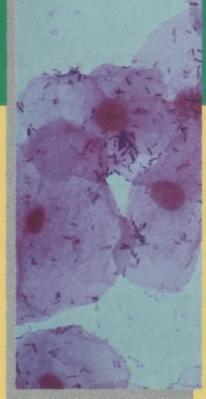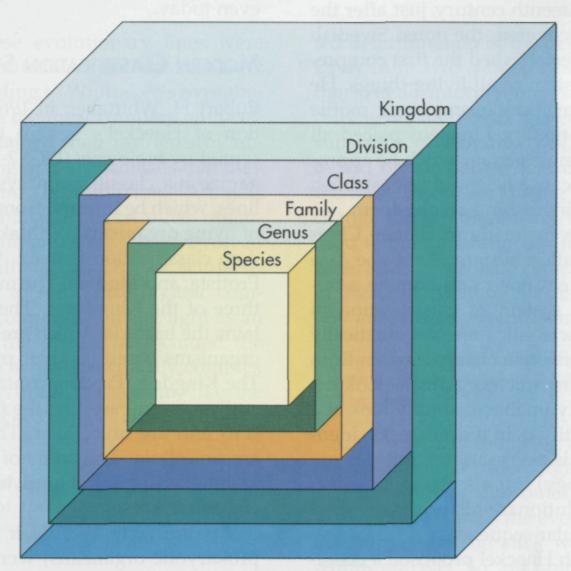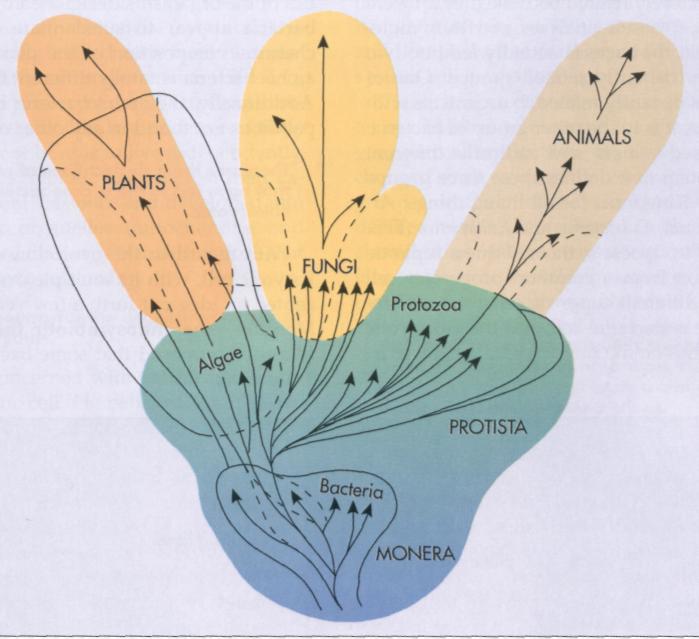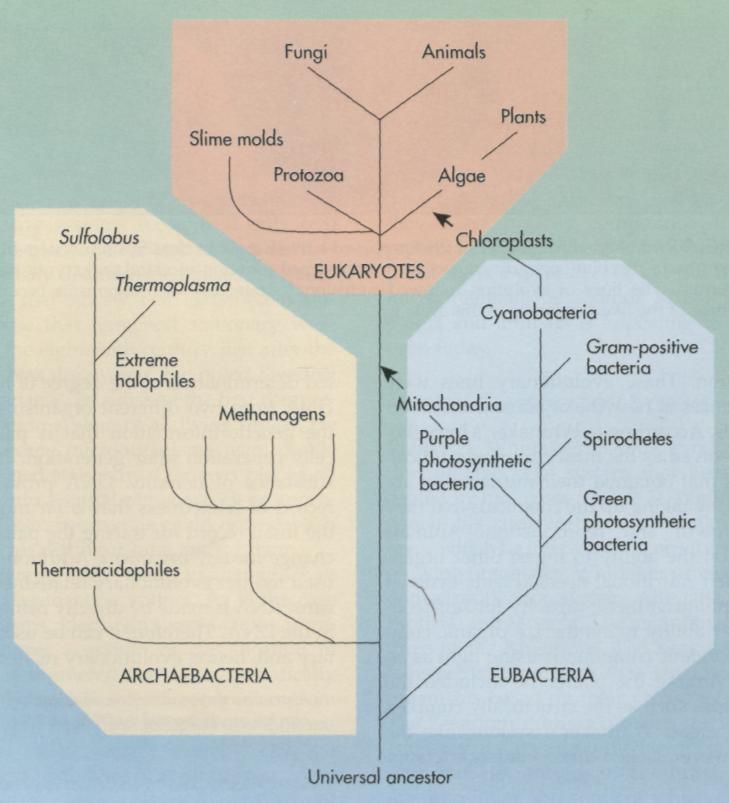
- •In this chapter we will:
- •Increased technological ability to examine the characteristic properties of organisms has permitted the establishment of more detailed and accurate classification systems for living things.
- •I table 2-1
- •Viruses
- •Viroids
- •Table 2-2
- •Table 2-3
- •38 Chapter 2 diversity of the microbial world
- •52 Chapter 2 diversity of the microbial world

Diversity of the Microbial World
Chapter Outline
Classifying Microorganisms 25
Early Classification Systems Modern Classification Systems Highlight: Evolution of Microorganisms Survey of Microorganisms 30
Acellular Nonliving Microorganisms
Viruses
Viroids
Prions Prokaryotes
Naming Bacteria
Characteristics Used in Classifying and Identifying Bacteria Methodology: DNA Hybridization: A Method for Analyzing Genetic Relatedness
Major Groups of Bacteria Highlight: Microview of Bacterial Diversity Eukaryotes
Fungi
Algae
Protozoa
Preview to Chapter 2
In this chapter we will:
Learn how microorganisms are classified.
See how microorganisms evolved.
Gain an overview of the microbial world by examining the fundamental characteristics of the various types of microorganisms.
Examine characteristics of the acellular, nonliving microorganisms—viruses, viroids, and prions.
Examine characteristics of the prokaryotic microorganisms—archaebacteria and eubacteria.
Examine characteristics of the eukaryotic microorganisms—fungi, algae, and protozoa.
See that the structural differences between acellular, prokaryotic, and eukaryotic microorganisms have practical importance in medical practice.
Learn the following key terms and names:
algae fungi
Archaea Gram-negative bacteria
bacteria Gram-positive bacteria
bacteriophage Monera
Bergey's Manual morphology
binomial name mycelia
DNA hybridization prions
endospores Protista
endosymbiotic theory of protozoa
evolution species
eubacteria taxonomy
eukaryotes viroids
evolution virus
evolutionary relatedness yeasts filamentous fungi five-Kingdom
classification system
CLASSIFYING MICROORGANISMS
The microbial world is extremely diverse. Some organisms have common features that permit grouping into common categories. Scientists use a hierarchical [ˌhaɪə'rɑːkɪk((ə)l)] (ranking system) organizational structure in which organisms are classified (grouped) according to their degrees of similarity (FIG. 2-1). Classification systems are used to systematically establish the characteristics of different groups of organisms so that specific types of organisms can be described and identified. The broadest groups in a classification system are called Kingdoms and the smallest are vcalled species. Related species are grouped into genera. For example, Mycobacterium tuberculosis and Mycobacterium leprae are both in the genus Mycobacterium.
The science of identifying and classifying organisms is called taxonomy, and scientists who study the classification of organisms are called taxonomists. Arguments among taxonomists are often quite heated. Some taxonomists tend to classify many similar organisms into large groups. Others favor small groups that emphasize even minor differences between organisms. Interpreting the evidence rests on personal judgement on the relative importance given certain criteria. Is shape, color, the ability to metabolize a given compound in a particular way, or something else the most important characteristic that should be used to distinguish one microbial species from another? Many modern taxonomists use evolu-
tionary relationships—determined by molecular biological analyses—as the basis for establishing order in classifying organisms.
Classification systems arrange living organisms into groups based on common factors and show how they are related.
It has been difficult to classify microorganisms based on how they are related to each other in terms of their evolutionary relationships. We use fossils that were preserved in the Earth's crust to piece together evolutionary relationships of plants and animals. Microorganisms lack structures such as bones and woody tissues that are preserved as fossils. There is only a limited fossil record that provides a basis for comparing ancient forms with contemporary forms of microorganisms. Direct examination of the ancestors of today's microorganisms is for the most part impossible. As a result, the classification of microorganisms generally has been based on relationships inferred from observed similarities and differences in morphology (form and structure) and physiology (functions) among actual living microorganisms.
The species is the fundamental grouping used in classifying ['klasəˌfī-ing] all organisms. In higher organisms the species is defined by the ability to interbreed and produce fertile offspring. Organisms that can interbreed [ˌɪntə'briːd] are considered members of the same species.

FIG. 2-1 The system used for the classification of living organisms employs hierarchical levels of organization: the highest level of organization (most encompassing) is the Kingdom; the species is the fundamental level of organization.
25
26 CHAPTER 2 DIVERSITY OF THE MICROBIAL WORLD
Those that cannot sexually reproduce fertile offspring are defined as members of different species. Many microorganisms, however, reproduce asexu-ally, with a single cell dividing to form progeny. Therefore, defining microbial species based on the ability to reproduce sexually is not meaningful.
Microbiologists have been hard pressed to find a working definition of a microbial species. Often, they consider a species as a group of microorganisms that have similar characteristics and that are significantly different from those of other groups. Thus, a bacterial species is a group of very closely related bacteria. Many bacterial species that are only genetically distantly related, however, have evolved similar morphological and physiological characteristics, making this definition ambiguous. DNA molecules (hereditary molecules) of all members of the same bacterial species have a very high degree of homology (similarity) to each other, and therefore modern classification systems increasingly rely on molecular analyses of DNA and RNA.
Early Classification Systems
Early classification systems date from the time of Aristotle, before the existence of microorganisms was known. These early systems recognized only two major groups — the plant and the animal Kingdoms — which could be easily distinguished based on motility. All organisms that moved were classified as animals and all those that remained stationary were called plants. In the eighteenth century, just after the microbial world was discovered, the noted Swedish botanist, Carl Linnaeus, established the first comprehensive classification system of all living things. He recognized that some microorganisms were motile and others remained stationary. Linnaeus placed all microorganisms into a single genus, which he appropriately named Chaos because he could not establish objective criteria for distinguishing among them.
Gradually, attempts were made to change Chaos into an orderly classification system. As is the case for higher organisms, identifying and naming a microorganism requires a system of classification in which the critical characteristics are systematically established that distinguish one microorganism from another. But because many microorganisms look exactly alike, we are usually unable to simply look at a microorganism and identify it. In most cases, to identify a microorganism, it is necessary to consider not only its form (morphology) but also its metabolism (physiology) and its evolutionary history as revealed in its genetics (its molecular sequences).
In 1866, Ernst Heinrich Haeckel proposed a classification system based on inferred evolutionary relationships among species. This was the first attempt to include evolution theory within a classification system. Evolution is the process of change that results
from the interaction between the genetic information and the environment of organisms of a species. Evolution results in the formation of new organisms that are better adapted to the environment. Modern classification systems attempt to reflect the gradual evolutionary changes that have resulted in the appearance of new organisms. Such phylogenetic classification systems (from the Greek phylo, meaning kind or type, and geny, meaning origin) categorize organisms based on their evolutionary relatedness.
A phylogenetic classification system takes into account evolutionary relatedness.
Haeckel's system contained three Kingdoms: Protista, Animalia, and Plantae. Haeckel proposed that the microorganisms—bacteria, fungi, algae, and protozoa—all belonged [bɪ'lɔŋ] to one primary Kingdom, which he called the Protista. The Protista were characterized by their simple structural organization, that is, by their lack of specialized tissues. Haeckel believed that the Protista was the first Kingdom to evolve and that both the Plantae and Animalia evolved from the Protista. They both had tissues ['tɪʃuː ]. The Plantae had specialized tissues and were photosynthetic, using light energy for growth. The Animalia also had specialized tissues but were heterotrophic, meaning that they used organic compounds for energy and growth. Although this system was somewhat naive, it did show a great deal of insight. Its recognition of microorganisms as a single Kingdom distinct from plants and animals is appealing to microbiologists even today.
Modern Classification Systems
Robert H. Whittaker, in 1969, proposed a modification of Haeckel's system that became widely accepted by biologists (FIG. 2-2). Whittaker tried to organize his classification system along evolutionary lines, which he inferred from observed characteristics of living organisms. Whittaker proposed a five-Kingdom classification system: Animalia, Plantae, Fungi, Protista, and Monera. The microorganisms constitute three of the Kingdoms. The Kingdom Monera contains the bacteria, which are separated from all other organisms based on their prokaryotic cell structure. The Kingdom Protista contains the unicellular algae and protozoa based on the fact they have eukaryotic cells and are unicellular. The fungi, some of which are unicellular and some of which are multicellular, are in the Kingdom Fungi, based on their lack of specialized tissues.
According to Whittaker, the Monera (bacteria— prokaryotic organisms) were the first organisms on Earth and the Protista (protists—eukaryotic unicellular organisms) evolved directly from the Monera. Whittaker proposed that fungi, plants, and animals evolved from the protists via three separate direc-
CLASSIFYING MICROORGANISMS 27

tions of evolution. These evolutionary lines were based on differences in how the organisms met their nutritional needs. According to Whittaker's hypotheses, the fungi evolved as the most complex multicellular organisms that obtained their nutrients by absorption, that is, by taking up the chemicals that they needed for growth and reproduction. Animals evolved based on the ability to ingest other organisms to meet their nutritional needs. Plants evolved based on their photosynthetic capacity for self-feeding, that is, their ability to synthesize organic compounds from inorganic compounds using light as an energy source. Among the plants, he included the multicellular algae, such as the structurally complex brown and red algae. Whittaker's system, like the earlier ones, however, lacked direct evidence to support its validity.
The five-Kingdom classification system of Whittaker is based on evolution of species from the prokaryotes (bacteria) along strategies ['strætəʤɪ] for obtaining nutrition.
In the early 1970s, developments in the field of molecular biology provided the first tools for directly examining the evolutionary relationships among microorganisms. Methods were developed that permit-
ted determination of the degree of relatedness of the DNA from two different organisms. DNA contains the genetic information that is passed to progeny cells generation after generation. It is the primary substance of heredity. DNA provides a molecular record of relatedness that is far more accurate than the fossil record for tracing the path of evolutionary change for any organism. Additionally, RNA can be used to infer evolutionary relatedness among organisms. RNA is made by directly using the information in the DNA. Therefore it can be used to infer hereditary and, hence, evolutionary relatedness.
A precise [prɪ'saɪs] determination of microbial relatedness can be made based on DNA or RNA nucleotide sequences.
Carl Woese, in the 1970s, analyzed RNA to explore the evolution of microorganisms. Woese reasoned that the RNA of ribosomes was changed only relatively slowly during the evolution of new organisms. Ribosomes are the sites where proteins are made within all cells. So, ribosomal RNA (rRNA) should not have changed much as a result of small evolutionary steps. Rather, rRNA should change significantly only as a result of major steps in evolution. Before Woese's studies, it was generally accepted that
28 CHAPTER 2 DIVERSITY OF THE MICROBIAL WORLD
all bacteria were closely related because they all were prokaryotic cells. Woese's analyses of rRNA molecules revealed that the bacteria actually fell into two distinct and only distantly related groups. One of these groups is as distantly related to organisms with eukaryotic cells as it is to the other group of bacteria. Woese proposed a new and radically different classification system that defines these three groups as three primary Kingdoms for all living things: Ar-chaebacteria (Archaea), Eubacteria, and Eukaryotes (FIG. 2-3). According to Woese's theory three separate paths of evolution from a common progenitor cell produced three different types of cells: the archae-bacterial cell, the eubacterial cell, and the eukaryotic cell. Further studies on the physiological characteris-
tics of the organisms designated by Woese as archae-bacteria appear to substantiate his proposal. The chemical composition of the plasma membranes of archaebacteria is totally different from all other cells. Additionally, the archaebacteria have metabolic capabilities not found in any other organisms.
There are three distinct lines of cellular evolution that have led to the archaebacteria, eubacteria, and eukaryotes.
With regard to the evolution of the modern eukaryotic cell, with its multiple ['mʌltɪpl]мorganelles, Woese accepted an idea put forth a few years earlier by Lynn Margulis—the endosymbiotic theory of evolution. Margulis proposed that some bacterial cells had be-

FIG. 2-3 The three-Kingdom classification system proposed by Carl Woese was developed using the modern techniques of molecular biology and, in particular, the examination of the RNA macromolecules of ribosomes. Unlike previous classification systems, the analysis of conserved gene products permits a direct assessment of genetic and, thus, evolutionary relatedness. Based on rRNA analyses, Woese found that there were three primary lines of evolution leading to the archaebacteria (Archaea), eubacteria, and eukaryotes. Modern eukaryotes have cells that incorporated mitochondria (derived from purple photosynthetic bacteria) and chloroplasts (derived from cyanobacteria); mitochondria and chloroplasts became organelles of eukaryotic cells by endosymbiosis.
CLASSIFYING MICROORGANISMS 29
gun to live within the predecessors of modern eu-karyotic cells in a mutually beneficial (symbiotic) relationship that probably helped each meet its metabolic energy and nutritional requirements (FIG. 2-4). Living together, the prokaryotic and eukaryotic organisms could help each other live under conditions where either might not be able to live independently. Eventually the endosymbiotic bacteria lost their capacity for independent existence and developed into two of the cellular organelles (mitochondria and chloroplasts) involved in energy transformations that are found in eukaryotic cells today.
Endosymbiosis accounts for the acquisition [ˌækwɪ'zɪʃ(ə)n]of or ganelles by eukaryotes. [
Woese was not concerned with the further evolution of the eukaryotic cell. He believed that the origins of the different types of cells, as revealed by the molecular record of evolution retained within DNA and rRNA molecules, should be used as the primary criteria in defining Kingdoms. Most microbiologists who concentrate their studies on organisms composed of one or relatively few cells readily accept this concept. However, many biologists who study higher organisms have difficulty in accepting Woese's system because it places all organisms with eukaryotic cells—including fungi, protozoa, algae, plants, and animals—into a single Kingdom, the eukaryotes. It is
not surprising that lumping humans into the same Kingdom as fungi and algae meets some resistance and it is likely that further modifications to Woese's system will be made to subdivide the eukaryotes.
Classification systems continue to develop based on our abilities to examine the characteristics of organisms. Classification of living organisms has changed from systems based on first observational glimpses at the microbial world to systems based on detailed molecular analyses. In the progression of classification systems, we see a quest to change chaos into order and to establish a system of classification that reflects evolutionary relatedness.
